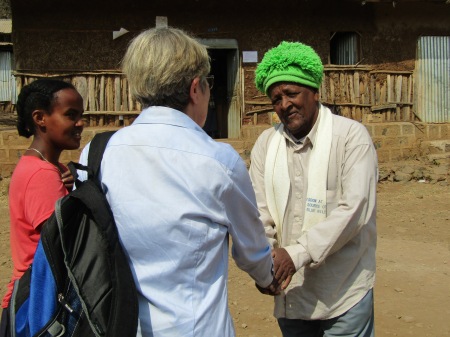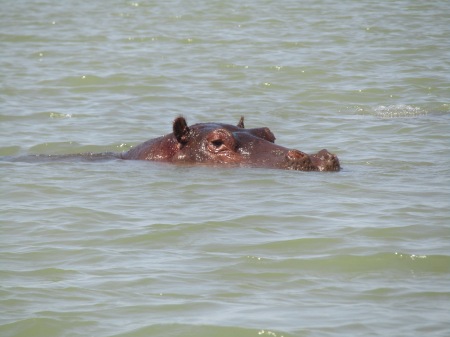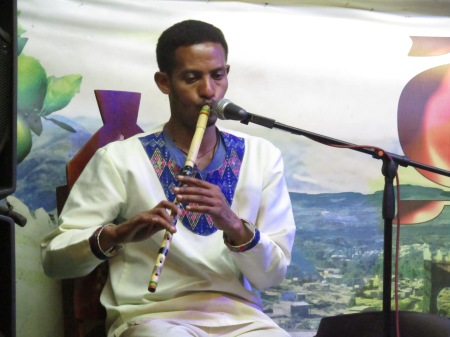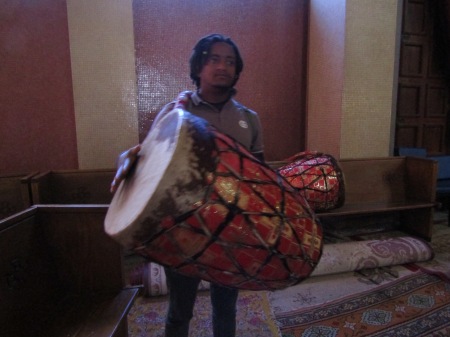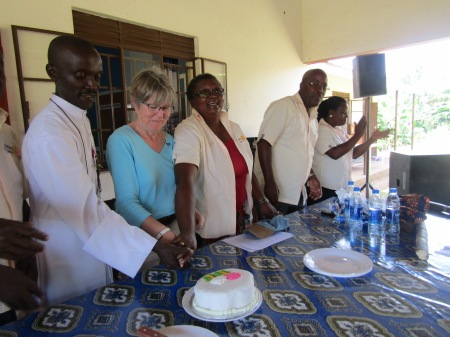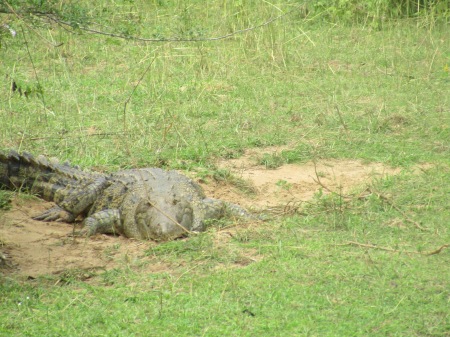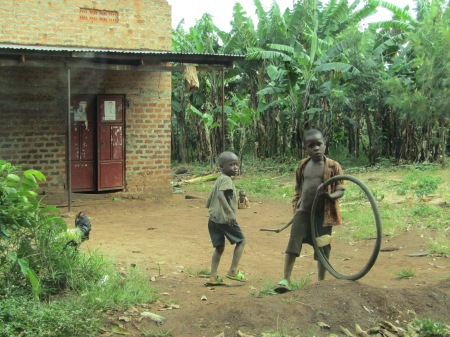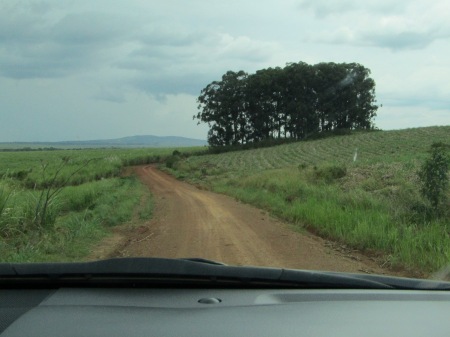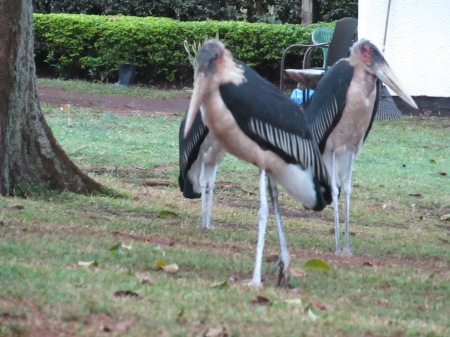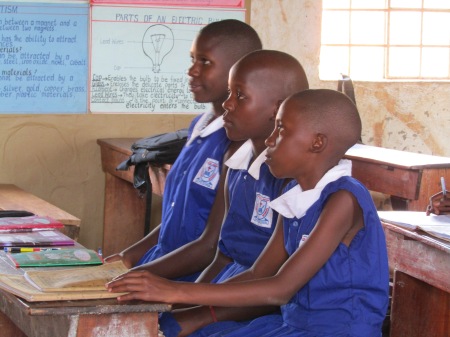
On Sunday morning the service at the Boothbay Harbor Congregational Church was all about hospitality. I was reminded that I have been made to feel welcome wherever I have traveled in the developing world, and that I have been an honored houseguest in Muslim, Hindu and Catholic households around the world.
On Sunday afternoon I was on my way to Uganda. Portland to Newark, Newark to Brussels, Brussels to a stopover in Kigali (Rwanda) and then on to Entebbe, where my African “sister” Juliet met me with two other Rotarians: Peace and Felicia. It was midnight – that’s what time aircraft from Europe arrive in Entebbe – but that didn’t keep them from insisting that I eat dinner and keeping up the conversation.
And it was a worknight! Juliet has a busy week this week – USAID is here to evaluate the new NGO for which she is executive director – and yet she has a houseguest. So she has made all sorts of arrangements for me that involve many other people, and no, I didn’t bring enough gifts. Ah, well! I also have a brand-new camera that I am still learning how to use – broke all the rules on that one.
I didn’t see her this morning – she went off to work and I slept late. Her teenage children are at home on school vacation so they laid out breakfast – lots of breakfast – just think of it as African food torture – and in a few hours Peace will come by to take me to for a school visit. More to come.
Wednesday morning.
Peace did come, around 3:00 pm, after more food torture and me enjoying the African sunshine. He drove me to a grammer school that the Kajjansi Rotary Club more-or-less adopted some years ago; I first visited in in 2014 and again in 2016. Everything has changed and grown, including the children! The most recent building is a dormitory for the teachers, and it already needs to be expanded. Teachers are paid for by the government – there doesn’t seem to be much trouble iwth that – but unless they have a place to live they can spend their entire income on rent and commutation expenses. So a place for them to live – particularly for unmarried women, who make up the backbone of primary school teachers – is really a necessity.
I had been given boxes and boxes of toothbrushes/toothpaste and floss, all more-or-less left over from BBH’s annual back-to-school “Set for Success” day. I had filled a huge suitcase with same, and Juliet knew that I was bringing them. The sets were hardly sustainable – there is no supply of toothpaste provided – so the sets were more a teaching device than anything else.
There were also very few students. It’s the first week of school; that’s part of the reason, but I think Peace was surprised that there weren’t more children in evidence. He later said that one of the problems the school has is not a strong principal. We shall see. Anyway, I demonstrated the toothbrush, toothpaste and floss – the latter was a real novelty – and if nothing else, I think a muzungu pretending to brush her teeth in public got their attention. Later we walked around the school and appreciated the growth over the past four years, took plenty of pictures, and left the principal with a bag of toothbrushes to give to the other students as they show up/enroll.
Off to a golf club for a cup of tea – how I love African tea, which is really Indian tea and what our chai is akin to – and many jokes about how the Kajjansi club takes its guests to the Kajjansi line – the slum – but seldom to the nicer side of town! And then to the club president’s house for barbecue.
It turns out that the president is the wife of Charles, who was club president in 2013-14. John Dennen had home stayed with them on that original trip, but I had never gotten past the driveway before. The house is beautiful; the garden ditto and the view out over Lake Victoria is a million-dollar view. The club officers and directors had been invited to meet me – partially this is becuase I will miss the weekly fellowship Wednesday night – and to enjoy the evening and the barbecue, which consisted of chicken and goat, two kinds of starch (white potatoes, matoke/banana), several vegetables, tomatoes, avocado, and I lost track at some point. I had brought along a handful of Rotary “peace” pins, and I gave them out to much acclaim and more photos – it’s entirely appropriate and very exciting, since the newest Rotary Peace Center is about to open here in Kampala at Makarere University.
A note on food. I really, really enjoy barbecued goat. It tastes like mutton, and is quite pleasant. When I explain that it is culturally just plain not on the menu in the US, I always get vacant stares. How can that be? Why not? And I can think of no reason why not. It just isn’t. Our loss.
After the meal, washed down (in my case) with more African tea, we went around the circle, with each Rotarian speaking in turn. I was amazed and yes, a bit flabbergasted at the club members’ discussion of the technical school project at Buikwe. That it was a game-changer, that it put the club on a whole new level; that sort of thing. I had known that when RI president Barry Rassin came to Uganda, the District had taken him to Buikwe. But it hadn’t occurred to me that the celebrity would rub off on the club. I should have been more aware. Also in their comments, several Rotarians (including Juliet) commented on the fact that we had trusted the club with a six-figure check without even, as Juliet said, knowing them for some time. Finally it was my turn to speak.
And I said that yes, the Otto and Fran Walter Foundation had written the check, but it had been Juliet’s vision and the club’s hard work that had made the technical school a reality. And I told the story of Otto Walter, and how he came to have a Foundation in his name. And I said that I had been Juliet’s houseguest for only a week, but that’s all it took to know that I could trust her -and by extension the Rotary Club – absolutely with the funding, which is how it had all happened And, of course, that I looked forward so much to seeing the technical school on Saturday with many of them.
At around 10:00 pm, someone remembered that it is a work night, and that I had to be up early in the morning, so goodbyes (until Saturday) were said and we were off to bed. I briefly packed, and then fell into bed, and was awakened in the middle of the night by the wind, which changed and slammed all the doors shut in the house, and then the rain began. And it really rained.
This is the middle of the dry season; a rain now is not only unexpected but can confuse the farming cycles. Should farmers plant now? Wait? Will it rain later on as well? You get the idea. Confused farming cycles equal bad harvasts and that equals starvation – this is no game. It’s clear that climate change is real, and having a real effect on peoples’ lives.
It’s also appropos because part of the conversation last night was about the weather – sounds like a boring conversation but far from it. It is hard for Africans to get their head around the fact that when we wake up in North America, we don’t know based on the calendar whether or not it is going to rain. How can we tell? How do we know what to wear? Isn’t it chaotic living without ongoing, intuitive knowledge of the weather? I have explained in the past that they have wet and dry seasons, we have hot and cold, but I expect, especially in an agrarian economy, our weather patterns can be unnerving.
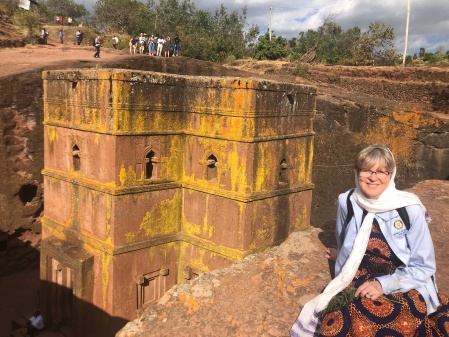



 Posted by martyhelman
Posted by martyhelman 
